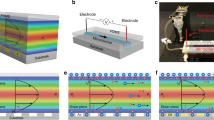Abstract
Dielectric liquids that show striking electrorheological (ER) effects are formulated by controlling the conductivity. Although the viscosity is increased on the application of a d.c. field, the flow of electrified fluids is Newtonian in the plain electrodes with smooth surfaces. When the liquids are sandwiched between the electrodes with flocked fabrics, the viscosity behavior is converted from Newtonian to shear-thinning flow. In electric fields, the convective flow is induced over the system due to the electrohydrodynamic(EHD) effect. The interactions between EHD convection and external shear give rise to the additional energy dissipation and in turn the increase in viscosity. The ER effects of simple liquids are very attractive in application to new fluid devices.




Similar content being viewed by others
References
Block H, Kelly JP (1988) Electrorheology. J Phys D Appl Phys 21:1661–1677
Honda T, Sasada T, Kuroiwa K (1978) The electroviscous effect in the MBBA liquid crystal. Jpn J Appl Phys 17:1525–1530
Orsay Liquid Crystal Group (1971) AC and DC regimes of the electrohydrodynamic instabilities in nematic liquid crystals. Mol Cryst Liq Cryst 12:251–266
Otsubo Y (1991) Electrorheological properties of barium titanate suspensions under oscillatory shear. Colloids Surf 58:73–86
Otsubo Y, Edamura K (1998) Viscoelasticity of a dielectric fluid in nonuniform electric fields generated by electrodes with flocked fabrics. Rheol Acta 37:500–507
Otsubo Y, Edamura K (1999) Electric effect on the rheology of insulating oils in electrodes with flocked fabrics. Rheol Acta 38:137–144
Suzuki M (1985) Propagating transition of electroconvection. Phys Rev A 31:2548–2555
Tanaka K, Koyama K, Yoshida T (1992) Transient stress responses of ER suspensions. J Soc Rheol Jpn 20:73–77
Winslow WM (1949) Induced fibration of suspensions. J Appl Phys 20:1137–1140
Worraker WJ, Richardson AT (1981) A nonlinear electrohydrodynamic stability analysis of a thermally stabilized plane layer of dielectric fluid. J Fluid Mech 109:217–237
Yang I-K, Shine AD (1992) Electrorheology of a nematic poly(n-hexyl isocyanate) solution. J Rheol 36:1079–1104
Yokota S, Hirata M, Kondoh Y, Suzumori K, Sadamoto A, Otsubo Y, Edamura K (2001) Micromotor using electroconjugate fluid. J. Robotics Mechatronics 13:140–145
Acknowledgement
This work was supported by a Grant-in-Aid for Scientific Research from the Ministry of Education, Science, and Culture, Japan, for which the authors are grateful.
Author information
Authors and Affiliations
Corresponding author
Rights and permissions
About this article
Cite this article
Edamura, K., Otsubo, Y. Electrorheology of dielectric liquids. Rheol Acta 43, 180–183 (2004). https://doi.org/10.1007/s00397-003-0337-4
Received:
Accepted:
Published:
Issue Date:
DOI: https://doi.org/10.1007/s00397-003-0337-4




